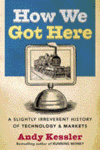| Home | About Us | Resources | Archive | Free Reports | Market Window |
The Birth Of Wall StreetBy
Tuesday, August 1, 2006
From its debut as a hot IPO, the Bank of the United States was capitalized with $8 million. The year before, in 1790, the new government of the United States of America sold $80 million in bonds to pay for the Revolutionary War and General Washington’s bar tab. Trading scrip on the muddy streets was no way to go through life, so the first organized stock exchange in New York was formed May 17, 1792 when 24 brokers and merchants met under a buttonwood tree that has since been replaced by a building at 68 Wall Street. Two centuries ago, standing on a soapbox was considered high tech. A stock exchange could not be much larger that someone’s voice could carry. These guys were hungry for action and someone had to move those bonds and scrip around. This group became the New York Stock & Exchange Board, and all sorts of bonds and other bank stocks began to change hands there. Traders made money via spreads. They would buy a stock at par value, say $100, and sell it at a $1-2 premium. After the Bank of the United States IPO mania, things settled down and got pretty dull. Stocks traded by appointment, literally. Twice a day, someone would slowly rattle off the names of stocks, and if anyone wanted to trade, they would do so after their names were called. In effect, the New York Stock Exchange, nicknamed the Big Board, created a cartel. By controlling the trading in self-defined “listed” shares, others couldn’t come in and low-ball their spreads and commissions. This monopoly was extended to member firms only, and required a license to trade at the exchange in listed shares with fixed commissions. The downside was a limit on liquidity, but the “members” didn’t care. That wasn’t their problem. There was leakage from the New York Stock Exchange. Further down Wall Street, traders would occasionally sneak out and trade “off-exchange.” These fixed commissions stuck until 1975. The monopoly was supposed to have ended in 1975 as well, though in practice it still exists today. Congress closed the Bank of the United States in 1811. Seems as if a few “friends” of congressmen wanted in on the loan business. Not surprisingly, a slew of state banks took up the slack, and many saw their stock trade at the NYSE. Another Bank of the United States was chartered in 1817, but it appeared to be terribly mismanaged. Andrew Jackson took office in 1829 and was convinced the Bank of the United States was corrupt and unconstitutional (banks aren’t mentioned in the constitution). Jackson vetoed the bill that would extend the Bank’s charter, set to expire in March 1836, and withdrew U.S. Treasury money from the bank. For his efforts, the Senate censured him. But since he ended up with his face on the $20 bill, he got his day in the long run. State banks and local banks looked at the absence of a central bank as a license to take over and lent money willy-nilly, to all takers. Speculation ran rampant in America in 1836. Out on the streets once again, people were trading stocks, bonds and any instrument they could. In 1836, the Exchange took action and forbade its members to trade out on the street, since that clearly threatened its fixed commissions. Credit tightened in 1837, and a Financial Panic took hold, ending the speculation. Hundreds of banks failed, trade businesses in New York shuttered, even the U.S. government had difficulty paying interest on its debt. It took several years for commerce and the economy to get back on its feet again. This was not the first or last time that speculation followed by panic created huge ups and downs for the capital markets, but each time the stock market survived and went about its business of providing capital to growing businesses. Good investing, Andy Kessler - An extract from How We Got Here by Andy Kessler. You can download a free copy of How We Got Here in PDF format by clicking here.
Market NotesTHE BIGGEST OF BIG OIL GETS BIGGER During the Hurricane Katrina-inspired rush to own oil stocks, ExxonMobil tried to climb above $65 a share. It failed. This spring, the $400 billion giant made another run at $65. The global asset sell-off helped push Exxon down again. Now, with all-time records of profitability being set, shares have blasted out to new highs. ExxonMobil’s efficiency is the envy of the oil industry. It’s one of a handful of companies with an ironclad AAA credit rating from Standard & Poors. Even if oil declines to $50 a barrel, ExxonMobil will make incredible amounts of money. As Exxon hits new highs and rakes in cash, it looks like the $400 million retirement package given to former CEO Lee Raymond may be a heck of a deal… The breakout of ExxonMobil (2-year chart):
|
Recent Articles
|


